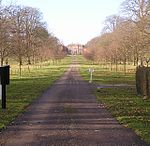Kerne Bridge railway station
Disused railway stations in HerefordshireFormer Great Western Railway stationsHerefordshire building and structure stubsHistory of HerefordshirePages with no open date in Infobox station ... and 4 more
Railway stations in Great Britain closed in 1959Railway stations in Great Britain opened in 1873Use British English from July 2017West Midlands (region) railway station stubs

Kerne Bridge railway station is a disused railway station on the Ross and Monmouth Railway constructed in the Herefordshire hamlet of Kerne Bridge which also served the village of Goodrich across the River Wye.
Excerpt from the Wikipedia article Kerne Bridge railway station (License: CC BY-SA 3.0, Authors, Images).Kerne Bridge railway station
B4234,
Geographical coordinates (GPS) Address External links Nearby Places Show on map
Geographical coordinates (GPS)
| Latitude | Longitude |
|---|---|
| N 51.869 ° | E -2.6101 ° |
Address
Kerne Bridge
B4234
HR9 5QT
England, United Kingdom
Open on Google Maps







